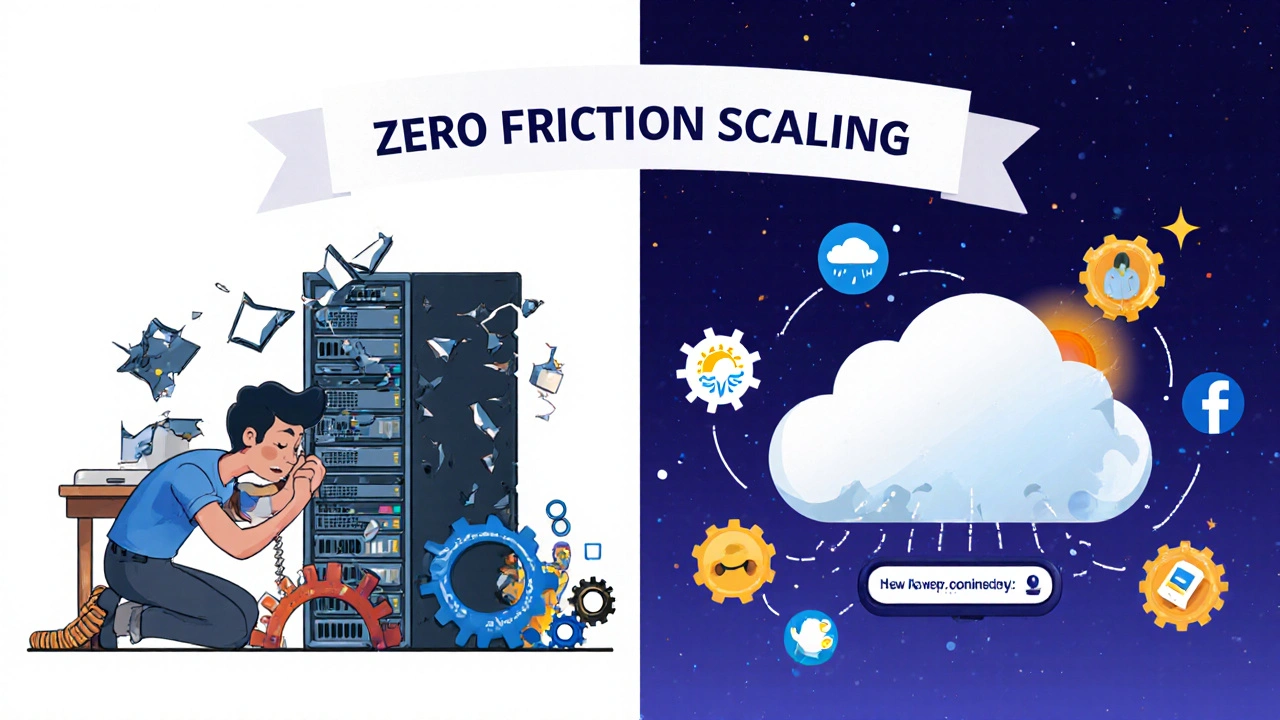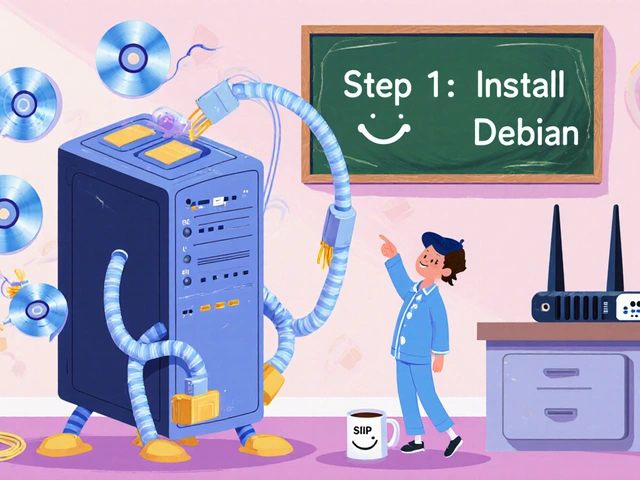Scalability in VoIP call centers isn’t just a nice-to-have feature-it’s the difference between surviving a holiday spike and collapsing under it. If you’ve ever watched your call center crash during a product launch, seasonal rush, or viral marketing campaign, you know the cost: lost sales, angry customers, and stressed agents. Traditional phone systems required weeks of hardware upgrades, new lines, and technicians crawling under desks. VoIP changed all that. Today, scaling your call center from 50 to 500 agents can happen in hours-not months. And it’s not magic. It’s architecture.
Why VoIP Scales So Fast
Think of traditional phone systems like a highway with only 23 lanes. Once all lanes are full, no more cars can get on-no matter how many drivers show up. That’s what PRI lines did: capped call volume at 23-30 concurrent calls per physical trunk. Add more? You needed more hardware, more wiring, more time.
Voice over IP (VoIP) turns that highway into a digital cloud. Instead of physical lines, calls travel as data packets over your internet connection. That means capacity isn’t limited by copper wires-it’s limited only by bandwidth and your subscription plan. No new phones to install. No new circuit boards to wire. Just log in, click a button, and assign a new agent a number. Vonage and 8x8 both confirm you can onboard a new agent in 15-30 minutes. No truck needed.
Enterprise platforms like RingCentral and Dialpad can handle up to 10,000 concurrent calls without breaking a sweat. And latency? Under 150ms. Jitter? Below 30ms. That’s not just functional-it’s smooth. Customers don’t hear delays or robotic voices. They just get helped.
Three Ways to Scale: On-Premises, Hybrid, Cloud
Not all VoIP systems are built the same. Your scalability depends on which model you pick.
- On-premises VoIP: You own the hardware. It’s cheaper upfront but scales poorly. You’re stuck buying SIP trunks-each costing $25-$50/month-and maxing out around 3,000 calls. Good for stable, medium-sized teams. Bad if you’re growing fast.
- Hybrid VoIP: Mixes some on-site gear with cloud services. Offers a middle ground. Useful if you’re transitioning from old PBX systems. But scaling still requires coordination between physical and digital layers. Slower than pure cloud.
- Cloud-based VoIP: This is where the real growth happens. Providers like Twilio Flex, 8x8 X Series, and VoiceSpin let you scale instantly. Need 200 more agents for Black Friday? Adjust your plan in the dashboard. Done. No technician. No downtime. Some platforms even auto-scale based on real-time call volume. Vonage’s Dynamic Scaling 2.0, launched in March 2025, predicts traffic spikes with 99.98% accuracy.
For most growing businesses, cloud-based is the only smart choice. It’s not just faster-it’s cheaper over time. You pay for what you use. Twilio lets you choose: pay per user, or pay per hour. Seasonal hires? Add them for a week. No long-term contract. No waste.
How Much Can You Really Scale?
Let’s get specific. Here’s what different providers can handle:
| Provider | Max Concurrent Calls | Scaling Speed | Best For |
|---|---|---|---|
| Nextiva Enterprise Cloud | 500 | Same day | Small businesses under 100 agents |
| Vonage Business Cloud | 5,000+ | 15-30 min per agent | Mid-market teams with seasonal spikes |
| RingCentral | 10,000 | Instant via portal | Large enterprises with steady volume |
| 8x8 X Series | 50,000+ | Real-time auto-scaling | Global, multi-channel contact centers |
| Twilio Flex | Unlimited (custom) | API-driven, code-based scaling | Tech-savvy teams with custom workflows |
Notice something? The bigger the operation, the more AI and automation come into play. 8x8 and Talkdesk now use AI to predict call volume, route tickets intelligently, and even suggest when to hire temporary staff. Talkdesk’s case studies show a 27% drop in average handle time during scaling events because bots handle routine questions before a human even picks up.

What You Need to Scale (Besides the Software)
Scaling VoIP sounds easy. Until your calls start dropping.
Here’s the hidden cost: bandwidth. Every concurrent call needs about 100kbps of upload/download speed. That’s not much-but multiply it by 100 agents? That’s 10 Mbps. By 200? 20 Mbps. By 500? 50 Mbps. And that’s just voice. Add video, chat, screen sharing? You’re looking at 100+ Mbps.
That’s why so many businesses hit a wall. One user on Reddit said: “We doubled our agents. Calls kept cutting out. Turned out our corporate internet was still on a 50 Mbps plan. We had to upgrade to 500 Mbps.”
Don’t make that mistake. Before you scale:
- Calculate your needed bandwidth: Number of concurrent calls × 100kbps
- Add 20% buffer for other business traffic (email, cloud apps, video meetings)
- Test your connection with a tool like Speedtest.net during peak hours
- Consider a business-grade internet plan-fiber if available
Also, check international limits. Aircall and others cap international calling to 20 countries unless you sign a custom enterprise deal. If you’re expanding globally, ask about number availability and compliance rules. Some countries require local data residency or specific certifications.
Real-World Scaling Stories
Let’s talk about what this looks like in practice.
An e-commerce company in Ohio went viral on TikTok overnight. Orders exploded. Their call center-built on VoiceSpin-scaled from 20 agents to 200 in 72 hours. No new phones. No new office space. Just emails sent to new hires with login links. They handled over 50,000 calls that week. No dropped calls. No customer complaints about wait times. Just a simple plan upgrade.
On the flip side, a mid-sized insurance firm in Texas added 150 agents in two days using RingCentral. But they skipped the bandwidth check. Their internet couldn’t handle the load. Calls became choppy. Customers hung up. They lost 18% of their inbound leads that week. They fixed it-by upgrading their internet-but it cost them time, money, and trust.
Another lesson: scaling agents ≠ scaling training. Forrester found that 22% of companies who scaled too fast saw customer satisfaction drop by 15+ points. Why? New agents weren’t trained. Scripts were outdated. CRM systems didn’t sync. Scalability isn’t just about technology. It’s about people, processes, and preparation.

How to Scale Your VoIP Call Center: A Step-by-Step Plan
Here’s how to scale without chaos:
- Assess your needs: How many concurrent calls do you expect? What’s your peak season? Use historical data. Don’t guess.
- Check your bandwidth: Use the 100kbps per call rule. Add 20% buffer. Test it.
- Choose your platform: Pick a cloud-based provider that matches your size. Nextiva for small teams. 8x8 or Vonage for mid-market. Twilio for custom needs.
- Upgrade your plan: Log into your provider’s admin portal. Click “Upgrade.” Done. No calls to support needed.
- Add agents: Send email invites. Assign extensions. Set up roles and permissions.
- Train and test: Run a mock call surge. Use 10-20 test agents. Check call quality, CRM sync, and routing.
- Monitor: Use dashboards to track AHT (average handle time), wait time, and abandonment rate. If metrics dip, pause and fix.
Most providers offer free scaling checklists. RingCentral’s guide includes a bandwidth calculator. Vonage’s training shows 85% of admins can handle scaling in under an hour after one tutorial.
What’s Next? The Future of Scalable VoIP
The next wave is automatic. Vonage’s Dynamic Scaling 2.0, 8x8’s AWS integration, and Twilio’s Predictive Scaling (coming late 2025) are removing human input entirely. These systems watch your call patterns, track weather, holidays, and even social media trends-and adjust capacity before you even realize you need it.
WebRTC is now supported by 92% of major VoIP platforms. That means new agents can join from any device-phone, tablet, laptop-without installing software. Just open a link. That’s the future: zero-friction scaling.
But here’s the warning: over-reliance on internet-based systems is risky. The FCC’s 2024 report flagged VoIP as vulnerable during power outages or ISP failures. Have a backup plan-like forwarding calls to mobile phones or using SMS as a fallback.
And security? CISA reports that 18% of businesses had security breaches during rapid scaling events. Why? New agents got access too fast, without proper permissions. Always use role-based access. Turn off unused features. Audit logins weekly.
VoIP scalability isn’t going away. It’s getting smarter. Faster. More automatic. The businesses that win are the ones who treat scaling like a system-not a crisis.
Can I scale my VoIP call center without hiring more staff?
Yes. Many VoIP platforms now include AI-powered auto-attendants, chatbots, and self-service menus that handle routine questions-like balance checks, store hours, or order status. Talkdesk and 8x8 show that AI can reduce live agent load by 30-40% during peak times. You still need humans for complex issues, but you don’t need to hire 100 new agents just because your call volume doubled.
How much does it cost to scale a VoIP call center?
It’s usually cheaper than you think. Most providers charge per user or per concurrent call. Adding 50 agents on Vonage might cost $1,000-$1,500/month extra-depending on features. Compare that to traditional systems: hiring technicians, buying SIP trunks ($50 each), and waiting weeks. With VoIP, you’re paying for usage, not hardware. Many companies save 65-80% on scaling costs compared to legacy phone systems, according to Gartner.
Do I need special internet for VoIP scaling?
You don’t need “special” internet, but you do need enough speed. Minimum 100kbps per concurrent call. For 100 agents, that’s 10 Mbps. Add 20% buffer for other apps, and you’re at 12 Mbps. For 200 agents, aim for 25 Mbps. For 500+, go fiber. Business-grade plans are worth it. Avoid consumer internet-no SLA, no support, and speed drops during peak hours.
What’s the biggest mistake when scaling VoIP?
Skipping the bandwidth check. Most failures aren’t caused by the VoIP system-they’re caused by the internet connection. Another big mistake: adding agents without training. New hires need scripts, CRM access, and soft skills. Without that, your call quality drops fast. And third: ignoring international rules. You can’t just add a number in Brazil or Germany without checking local telecom laws.
Is VoIP better than traditional phone systems for scaling?
Absolutely. Traditional PBX systems take weeks to scale. You need physical hardware, new lines, and on-site techs. VoIP scales in minutes. You can add agents from anywhere in the world. You can pause and resume service based on demand. You can integrate with CRM, email, and chat-all in one platform. The flexibility, speed, and cost savings make VoIP the only viable option for any business planning to grow.
Final Thoughts: Scalability Is a Strategy, Not a Feature
Scalability in VoIP call centers isn’t about buying more lines. It’s about building a system that grows with you. The best call centers don’t react to spikes-they anticipate them. They use data, automation, and cloud infrastructure to stay ahead. If you’re still using old hardware, you’re not just behind-you’re vulnerable. The market has moved. The tools are here. The question isn’t whether you can scale. It’s whether you’re ready to.









Nathan Pena
30 Oct 2025 at 07:47Let’s be brutally honest - most businesses think ‘scalability’ means clicking a button and magically having 500 agents. The reality? It’s a symphony of bandwidth, QoS, SIP trunk optimization, and proper DSCP tagging. If your network isn’t engineered for real-time traffic with 99.99% uptime SLAs, you’re not scaling - you’re just delaying an inevitable collapse. And don’t get me started on ‘cloud VoIP’ vendors who advertise ‘unlimited’ capacity while throttling at 8,000 concurrent calls. It’s marketing theater. Real scalability requires infrastructure audit trails, jitter buffers, and packet loss monitoring - not just a dashboard toggle. If you’re not using Wireshark to validate your call paths, you’re flying blind.
Also, ‘Dynamic Scaling 2.0’? That’s just predictive analytics wrapped in buzzwords. Vonage’s algorithm is trained on historical data, not actual chaos. What happens when a viral TikTok surge doesn’t follow historical patterns? Your system over-provisions, burns cash, and still drops calls. Scalability isn’t automated - it’s architectured. And most SMBs don’t have the ops team to do it right.
And yes, I’ve seen this exact scenario play out in three Fortune 500 rollouts. Bandwidth is the silent killer. Always.
Also, WebRTC is great until your user’s ISP is Comcast. Then your jitter spikes to 400ms and your ‘zero-friction’ solution becomes a customer service nightmare. Don’t trust the vendor’s demo lab. Test in production conditions. Always.